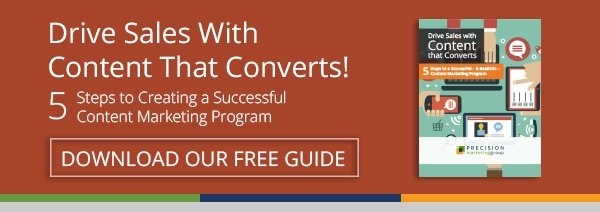You love your work. That’s what makes you good at it.
You live and breathe your work, which is why you’re sometimes terrible at promoting it.
This isn’t a judgment; it’s a fact. Many entrepreneurs and small business owners are stuck in the selling mindset. They’re so caught up in the environment of their brand and industry, they forget that clients are indifferent to market landscapes.
Why is it so hard to think like a buyer? Blame your business plan. After months or years of developing an insider perspective, it’s difficult to make a layman’s case for your company. Besides, you use your business plan to make financial decisions and staffing decisions. Why not as a marketing strategy guide?
The following post explains why not. Here’s how your business-plan thinking (i.e. “seller focus”) may be clashing with your prospects’ needs (buyer focus):
EARLY STAGE
Seller Focus: Your Product/Service Description
Buyer Focus: “I Need Help!”
Your marketing starts with a definition of who you are and what you do. Your buyer starts with a problem. (Her company network has crashed. Her staff is asking for advanced training. She needs customized swag to give away at next month’s conference.)
Theoretically, the description of what you do should be an answer to the problem your prospects are trying to solve. But there are reasons why the two don’t line up—at least not in the early stages.
When clients are first beginning to recognize their problems, it’s often true that seller/buyer language doesn’t agree. You may be talking about “corporate promotional items” or “imprinted, tubular-knit lanyards…” Meanwhile, your prospective customers are Googling “custom key chains.” See the disconnect?
When crafting keyword content for your web pages, landing pages, and social media posts, you need to divorce yourself from in-house terms, and begin to speak broadly, colloquially—even if this invites some less-than-perfect leads. Further down the funnel, there will be opportunities to get specific, addressing more precise offerings and granular features.
MID STAGE
Seller Focus: Your Market Analysis
Buyer Focus: “Do These Guys Have What I’m Looking For?”
Your business was built on a keen understanding of your industry. You have years of experience and accomplishments. You’ve probably studied historic trends and projected growth rates. Maybe you’ve even published some articles or guidebooks. These distinctions set you apart from your competitors...
And yet, they may be totally irrelevant to buyers. Make no mistake, inbound marketing is about building trust and credibility, plus educating prospects as they move throughout the buying cycle. Too much context, however, can begin to make your messaging feel like a midterm exam.
When buyers reach your website, they’re at the stage of considering options and beginning to form preferences. Help them to like you and remember you (since they probably won’t buy right now) by using customer-centric terms and menu links that clearly map your different verticals. For example, if you sell your custom key chains differently to auto body shops versus hair salons, your site should include obvious paths for the different audiences.
Use your page’s best real estate (above the fold) to rephrase your benefit statements and provide lead nurturing offers: e-Books, white papers, case studies, etc. These materials can delve into the proof points you want to emphasize, without overwhelming visitors’ first experiences.
Don’t use homepage modules and sidebars for lengthy testimonials or your company history. Instead, offer separate links to your resources and “about us/meet the team” sections. (And in fact, most customers do respond better to companies that offer a personal face). Just remember that context building shouldn’t precede calls to action, or, in other words: opportunities for visitors to find and buy your products/services.
LATE STAGE
Seller Focus: Your Value Summary
Buyer Focus: Should I Contact This Company? Today?
Your leads have found you—and they like you!—but they’re still up in the air about what to do next. If you rely on your selling mindset, you may just fall back on more emphatic summations. More superlatives. More exclamation marks. More statements of urgency. After all, you’ve already explained your terrific products and services, right?
More of the same messaging won’t compel most buyers to act unless their problem suddenly gets worse, or unless all your competitors are dropping the ball, too. Give your leads a smaller step to take before an actual purchase. Offer a free trial or product demonstration. This removes some of the trepidation about making contact because it’s not necessarily a commitment. At the same time, you’re solidifying the relationship you’ve nurtured, and bringing the conversation to a one-on-one level.
Of course, there’re a lot more to inbound marketing than just recognizing these three buyer questions. The best strategies explore specific buyer personas, buying triggers, advanced keyword research, and progressive profiling/segmentation with corresponding content marketing. But those are posts for another day!




